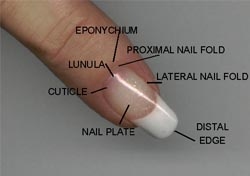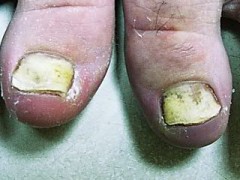Nail Structure & Growth
Nails grow at the end of fingers and toes, primarily serve as a protection, despite the current trends of decorating them with different paintings and colourings for cosmetic purposes.
The many different shapes and status of the nails actually tell us quite a lot about the internal conditions of our body. If you find usual changes in colour, shapes, smoothness, and separation from the nail beds, you should consult a dermatologist.
The main structure of the nail is the nail plate, which is a flat piece of dead protein called keratin, and is formed by flattening of the keratinocytes as they divide, migrate upwards and die. The nail plate is half-transparent.

The only living part is the nail root called the matrix, which is delineated by the ‘half moon’ lunula that marks its margin. The matrix extends into and under the proximal nail fold, which is normally tightly adhered to the nail plate by the cuticle to prevent entry of water.
About one quarter of the nail is beneath the proximal nail fold and the exposed part is attached to the nail bed, which has a profuse blood supply and provide the nail its pink colour.
The tip of the nail is not attached to the nail bed. This part is yellowish-white colour and this is where we trim our nails. In some diseases, the separation begins from here and extends into the nail bed.
The nail fold is normally attached to the nail plate and is watertight. When the nail fold is detached, its waterproof properties are lost allowing various organisms and irritants to wash under it, and potentially set up infection or irritation in the nail bed and matrix. The nail fold swells in this situation and is further detached, and a vicious circle is set up, and may potentially damage the whole nail.
A typical example is Candida, which enter via this route. Other nail fungal infections, on the other hands, start usually from the free ends and the lateral sides. To protect the integrity of the nail fold, you have to prevent wetting the hands, or coming into contact with some irritants, for a long period.
The nail grows only slowly. It normally takes 5 - 6 months for the fingernails, and 9 - 12 months for the toenails, to grow out. The grow rate may be different in different nails, even in the same hand or foot.
During an episode of severe illness, the nails will grow a lot slower, until the recovery. The nail grown during this period forms a separation line from the part of nail before the illness. On the contrary, the nails in psoriasis grow a lot faster.
Tinea Unguium
It is usually due to fungal infection of the toe or finger webs, under a hot and humid environment, which later spreads onto the nails. Sometimes the fungus may directly invade the nails.
The infection starts from the free ends, or the lateral sides, and extends towards the matrix. Tinea unguium is mainly a problem of the adults, and only rarely affects children under the age of 10.
Signs
The affected nail becomes thickened, loses its lustre and appears yellowish-grey in colour. The nail material is no longer hard and is brittle, with crumbled bits coming off at the distal free end. Part of, or even the whole nail may be separated from the nail bed (onycholysis).

There may be co-existing signs of fungal skin infection in the nearby skin.
Clinical Diagnosis
With good experience, the doctor may be able to diagnose this easily from the appearance. If a definitive diagnosis is required, or when it is confused with other possible causes, then a sample can be obtained by cutting off some of the nail and sent to the laboratory for examination under the microscopy, or for culture.
Many other skin problems may have similar signs in the nails, especially psoriasis where the nail appearance can be very similar. This is when laboratory test may become necessary.
Treatments
The growth of a nail is rather slow. To grow from the matrix to the distal end, it takes 4 to 6 months for the fingernails, and 6 to 12 months for the toenails. Therefore to cure a nail that is infected by fungus, all treatments will require a course of a few months, so as to allow the infected nail to grow out and replaced by new un-infected nail.
External Cream
The fungi exist deep inside the nail material, the nail bed and the matrix. Cream cannot deliver the active ingredients to penetrate deep enough, and is therefore rather useless.
Medicated Nail Lacquer
Active anti-fungal ingredients can be added into nail lacquer, which is painted onto the nail surface and let dry. This allows a much longer contact and the ingredients can have long enough time to penetrate more into the nail material. Either because of incomplete penetration, or the presence of fungi in the matrix, the effectiveness is still only about 60 - 70% after a treatment period of 6 months.
The advantage of this treatment is that it has almost no side effects; the use is simple; and only needs to be painted on once a week.
It is probably the first choice of treatment in cases where there are only less than 2 or 3 nails affected, or when the person is concerned with the side effects of oral treatment.
Oral Treatments
When the infection is severe, with grossly damaged nails; or when there are many nails affected; or after the trial of medicated nail lacquer has failed, then it is necessary to move on to use oral medications. These are prescription medicines and need to be taken under the supervision of the doctors.
In the past, the standard treatment had been griseofulvin. This only inhibits the growth and does not truly kill the fungi. Treatment used to take 1 year or longer. More and more fungi have become resistant to it, and it is no longer used.
Ketoconazole was once popular with good results, but it has a relatively higher incidence of causing liver damages and is also substituted by others. It still has a place as ketoconazole shampoo, in treating fungal infection of the scalp and seborrhoeic dermatitis.
Terbinafine and Itraconazole can actively kill the fungi, and they have good penetration properties into the nails. The treatment course can be reduced to only 4 months, with an effective cure rate up to 90%. They are taken once daily. Although they may have possibility of causing liver damages, but when taken under proper supervision, this possibility and other side effect are very low.
Itraconazole can be taken in a cyclical regime with similar effectiveness. A higher dose is taken daily for 1 week, then stopped for 3 weeks, when the cycle is repeated again. It usually requires 4 or more cycles.
If there is concern regarding the possibility of liver damages, a blood test to check the liver enzymes levels can be performed during the course of treatment.
Surgery
Occasionally when the nail is totally distorted or damaged, it may be necessary to remove the whole nail surgically, and let a new piece to nail grow back again.
How To Prevent The Recurrence
- Minimise the time of wearing shoes.
- Shoes and socks should be non-occlusive and made of airy materials.
- Use of anti-fungal powders in shoes and socks, to help absorb sweats and inhibit the growth of fungi.
- Avoid sharing slippers or shoes with family members who have fungal infection of the feet or nails. Do not walk with bare feet on the floor.
Other Causes of Nail Shape Changes
Diseases of the nails can affect the appearance of the nail plate and the surrounding tissues. The nail can also reflect on other internal health conditions of the body. Abnormal changes of the nail can occur in its:
- Shape
- Surface
- Texture
- Colour
The scope of this area is very wide and it is not possible to list them all out here. The following only mentions some of the more common examples, and if there is any doubt, medical advice should be required.
Shape
- Chronic heart and lung diseases will cause a drop in the blood’s oxygen level. The nail will become a round bulb shape and the colour will become purplish-red.
- Chronic iron-deficiency anaemia will cause a spoon-shaped indentation. The colour will appear white.
- Nails that lack proper care and trimming for a long time will have an exaggerated curve inwards like a clamp on the nail bed.
Surface
- Longitudinal grooves along the length can be a normal phenomenon, but it can be due to a benign tumour or wart in the matrix.
- Longitudinal raised lines have many causes. It can be simply normal, but can also be due to old age, self-inflicted injuries, genetics, and tumours.
- Horizontal lines may represent a severe illness at a certain time in the past, or due to eczema of the surrounding skin.
- Small, pitted holes may be due to alopecia areata, psoriasis, eczema, but occasionally may happen in normal situations.
- Roughened surfaces are usually related to long-term exposure of irritant liquid, or may be related to psoriasis, fungal infection, or eczema.
- Brittle, flaky surface is usually due to long term contact with irritant liquid or water, but may be related to old age or psoriasis.
Texture
- Fungal infection, psoriasis can make the nail thickened, brittle, and easy to crumble.
- Localised injury; chemicals; long-term water contact; and iron, vitamins A, C, and B6 deficiency will make the nail softened and brittle.
Colour
Some medications and chemicals may change the colour of the nails. It may be contacted accidentally or is used for a medical treatment. Colour changes due to diseases are usually white, black, brown, green or yellow.
- White: can be due to separation of the nail from the nail bed, fungal infection, psoriasis, heart and lung diseases, kidney diseases, or anaemia.
- Black or brown: can be due to clotted blood under the nail after an injury, fungal infection, a naevus or rarely a malignant skin tumour (melanoma) in the nail bed.
- Green: usually due to bacterial or candidal infection.
- Yellow: can be due to over-slow growth, candidal infection, or medications.
Lastly, the nail plate may be separated from the nail bed in a lot of situations, such as trauma, psoriasis, eczema, fungal infection, iron-deficiency anaemia, hyperthroidism, pregnancy, or any major illnesses.

